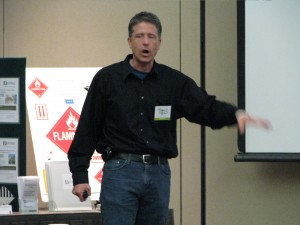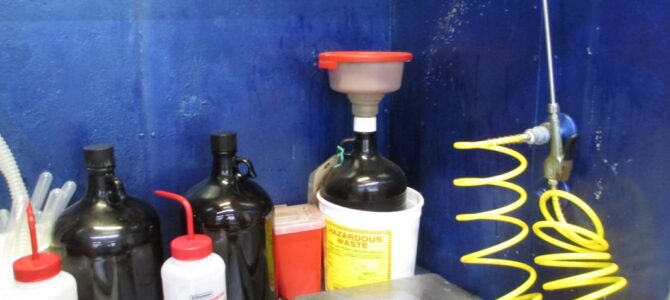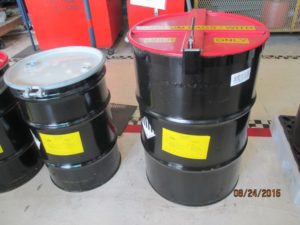Generators that accumulate waste in a satellite accumulation area (SAA) must comply with the regulations of 40 CFR 262.15. This includes maintaining waste below certain volume and/or weight thresholds and then complying with specific requirements when those thresholds are exceeded. Prior to the Generator Improvements Rule the regulations specifying generator requirements after the threshold weight or volume was exceeded in a SAA were not clear; the revised regulations change this.
The purpose of this article is to explain the regulations at 40 CFR 262.15(a)(6) that more clearly state the generator options for managing “excess waste” in a satellite accumulation area.
Before we begin…
- This is one article in a series that reviews all of the changes made to §262.15 by the Generator Improvements Rule.
- The location of these regulations within Title 40 of the Code of Federal Regulations (CFR) was changed by the Generator Improvements Rule. The satellite accumulation area regulations were located at 40 CFR 262.34(c), they are now found at 40 CFR 262.15.
- A clarification of the term “excess waste” is included later in this article.
- FAQ: What is a satellite accumulation area?
- FAQ: What is a central accumulation area?
Scope and Applicability:
- Accumulation of hazardous waste in a SAA is an option for both a large quantity generator of hazardous waste (LQG) and a small quantity generator of hazardous waste (SQG). Very small quantity generators of hazardous waste (VSQG) don’t have to comply with SAA regulations per §262.14(a).
|
Not sure of your hazardous waste generator category? |
- These new regulations were created by the Generator Improvements Rule, which may not yet be adopted by your state. FAQ: What is the status of the Generator Improvements Rule in my state?
- A generator may accumulate either or both of the following in a SAA:
- Acute hazardous waste
- Non-acute hazardous waste (aka: hazardous waste).
- The thresholds for waste accumulation in a SAA are specified at §262.15(a):
- 1 quart for a liquid acute hazardous waste.
- 1 kilogram or 2.2 pounds for a solid acute hazardous waste.
- 55 gallons for a non-acute hazardous waste.
40 CFR 262.15(a)(6):
(6) A generator who accumulates either acute hazardous waste listed in §261.31 or §261.33(e) of this chapter or non-acute hazardous waste in excess of the amounts listed in paragraph (a) of this section at or near any point of generation must do the following:
(i) Comply within three consecutive calendar days with the applicable central accumulation area regulations in §262.16(b) or §262.17(a), or
(ii) Remove the excess from the satellite accumulation area within three consecutive calendar days to either:
(A) A central accumulation area operated in accordance with the applicable regulations in §262.16(b) or §262.17(a);
(B) An on-site interim status or permitted treatment, storage, or disposal facility, or
(C) An off-site designated facility; and
(iii) During the three-consecutive-calendar-day period the generator must continue to comply with paragraphs (a)(1) through (5) of this section. The generator must mark or label the container(s) holding the excess accumulation of hazardous waste with the date the excess amount began accumulating.
|
Interested in a Webinar that covers this topic, and more! |
What’s it mean?
USEPA did not view this as a substantive change to the SAA regulations. Instead, it is a clarification of the generator’s options once the weight or volume threshold in a SAA is exceeded.
When the weight or volume threshold is exceeded, the generator must do the following:
- Immediately mark or label the container(s) of “excess waste” with the date.
- Continue to comply with all of the container and hazard communication requirements of §262.15(a)(1-5) for management of containers in a SAA.
- Within three consecutive calendar days do one of the following:
- Begin managing the waste in the SAA under the applicable generator (LQG or SQG) regulations for a CAA. In this case the SAA becomes a CAA and the containers don’t move.
- Remove the container(s) to a CAA managed subject to the applicable generator (LQG or SQG) regulations.
- Remove the container(s) to an on-site treatment, storage, or disposal facility (interim status or permitted).
- Remove the container(s) to an off-site designated facility.
Q: Can I remove the container(s) to another SAA?
A: Nope. That is not an option. (RO 14703 / FAQ #11, p. 8)
What is “excess waste”?
A point of confusion in these regulations is the term “excess waste”. Or, as it reads at §262.15(a)(6), “…in excess of the amounts listed in paragraph (a) of this section…” It is meant to refer to any waste that exceeds the weight or volume threshold in the SAA, i.e., 55 gallons for a non-acute hazardous waste, 1 quart for a liquid acute hazardous waste, or 1 kilogram (2.2 lb) for a solid acute hazardous waste. Unfortunately, as the regulation read prior to the revision, and as it reads now, it may be interpreted to refer solely to the waste accumulated in excess of the weight or volume threshold and not the waste accumulated prior to exceeding the weight or volume threshold. This could lead to a situation in which only the “excess waste” is removed time and time again, leaving the remaining waste behind indefinitely.
Commenters suggested the regulations be revised to require that the waste that was in the SAA prior to the generation of the “excess waste” be removed from the SAA, not just the “excess waste”. Under this recommendation, if a generator has a 55-gallon drum in a SAA and that drum becomes full, the generator would begin accumulating newly generated waste – i.e., “excess waste” – in a second 55-gallon drum. The full 55-gallon drum would be the container marked or labeled with the date of accumulation and removed from the SAA within three consecutive calendar days.
|
Daniels Training Services, Inc. 815.821.1550 |
USEPA agreed with this and during the development of the proposed rule it sought to revise this aspect of the SAA regulations. Unfortunately, during the development of the proposed rule, USEPA’s attempts to convey this idea through regulatory changes were unsuccessful and were not included in the revised regulations. However, USEPA endorses this practice (removal of the waste generated prior to exceeding the weight volume threshold) as a best management practice for removing waste from a SAA.
Conclusion:
Management of waste in a SAA provides many opportunities for the generator and a break from many regulations applicable to waste managed in a CAA. However, §262.15 contains many regulatory requirements and responsibilities for the generator in order to use those opportunities and breaks. Make certain you are in compliance with all the regulatory requirements of your hazardous waste generator category.

Be sure your RCRA Training addresses the regulations of your state.

